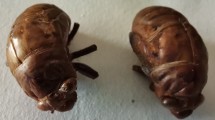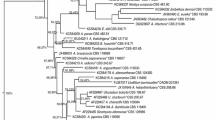Abstract
Entomopathogenic fungi are a rich source of natural bioactive compounds. To establish cultivation conditions which facilitate the production of bioactive compounds and to select good genera among entomopathogenic fungi as the producer, 47 typical entomopathogenic fungi were tested for their ability to produce antibiotic activity. Thirty-eight strains (81%) and 30 strains (64%) of these fungi produced either anti-Bacillus compounds or anti-Staphylococcus compounds, respectively, indicating that the majority of the entomopathogenic fungi tested possessed the ability to produce antibacterial compounds. Using 9 representative strains (Aschersonia sp. HF724, Beauveria bassiana HF338, Cordyceps ramosopulvinata HF746, Metarhizium anisopliae HF293, Metarhizium flavoviride HF698, Nomuraea rileyi HF588, Paecilomyces fumosoroseus HF254, Paecilomyces tenuipes HF419, and Verticillium lecanii HF238), the cultivation conditions in liquid medium were surveyed with respect to the cultivation procedure and medium composition, particularly in terms of the presence or absence of insect-derived materials. At 26 °C, M. anisopliae HF293, N. rileyi HF588, and V. lecanii HF238 strains produced clear antibiotic activity against Bacillus and Saccharomyces, but only in the presence of insect-derived materials, suggesting that the production of antibacterial/antifungal compounds by entomopathogenic fungi is triggered by the presence of insect-derived materials.
Similar content being viewed by others
References
DD Hegedus GG Khachatourians (1995) ArticleTitleThe impact of biotechnology on hyphomycetous fungal insect biocontrol agents Biotechnol Adv 13 455–490 Occurrence Handle10.1016/0734-9750(95)02006-O Occurrence Handle14536097
PA Shah JK Pell (2003) ArticleTitleEntomopathogenic fungi as biological control agents Appl Microbiol Biotechnol 61 413–423 Occurrence Handle12764556
H Liu M Skinner BL Parker M Brownbridge (2002) ArticleTitlePathogenicity of Beauveria bassiana, Metarhizium anisopliae (Deuteromycotina: Hyphomycetes), and other entomopathogenic fungi against Lygus lineolaris (Hemiptera: Miridae) J Econ Entomol 95 675–681 Occurrence Handle12216806
RI Samuels IC Paterson (1995) ArticleTitleCuticle degrading proteases from insect moulting fluid and culture filtrates of entomopathogenic fungi Comp Biochem Physiol B Biochem Mol Biol 110 661–669 Occurrence Handle10.1016/0305-0491(94)00205-9 Occurrence Handle7749618
S Jess JF Bingham (2004) ArticleTitleBiological control of sciarid and phorid pests of mushroom with predatory mites from the genus Hypoaspis (Acari: Hypoaspidae) and the entomopathogenic nematode Steinernema feltiae Bull Entomol Res 94 159–167 Occurrence Handle10.1079/BER2003286 Occurrence Handle15153298
N Claydon J Grove (1982) ArticleTitleInsecticidal secondary metabolitic products from the entomogenous fungus Verticilliun lecanii J Invertebr Pathol 40 413–418 Occurrence Handle10.1016/0022-2011(82)90180-X
MM Wagenaar DM Gibson J Clardy (2002) ArticleTitleAkanthomycin, a new antibiotic pyridone from the entomopathogenic fungus Akanthomyces gracilis Org Lett 4 671–673 Occurrence Handle11869098
PA Shah JK Pell (2003) ArticleTitleEntomopathogenic fungi as biological control agents Appl Microbiol Biotechnol 61 413–423 Occurrence Handle12764556
E Quesada-Moraga A Vey (2004) ArticleTitleBassiacridin, a protein toxic for locusts secreted by the entomopathogenic fungus Beauveria bassiana Mycol Res 108 441–452 Occurrence Handle10.1017/S0953756204009724 Occurrence Handle15209284
C Wang A Skrobek TM Butt (2004) ArticleTitleInvestigations on the destruxin production of the entomopathogenic fungus Metarhizium anisopliae J Invertebr Pathol 85 168–174 Occurrence Handle10.1016/j.jip.2004.02.008 Occurrence Handle15109899
M Sugimoto M Koike N Hiyama H Nagao (2003) ArticleTitleGenetic, morphological, and virulence characterization of the entomopathogenic fungus Verticillium lecanii J Invertebr Pathol 82 176–187 Occurrence Handle10.1016/S0022-2011(03)00014-4 Occurrence Handle12676554
RJ St Leger MJ Bidochka DW Roberts (1994) ArticleTitleCharacterization of a novel carboxypeptidase produced by the entomopathogenic fungus Metarhizium anisopliae Arch Biochem Biophys 314 392–398 Occurrence Handle10.1006/abbi.1994.1458 Occurrence Handle7979380
C Au P Dean SE Reynolds RH ffrench-Constant (2004) ArticleTitleEffect of the insect pathogenic bacterium Photorhabdus on insect phagocytes Cell Microbiol 6 89–95 Occurrence Handle10.1046/j.1462-5822.2003.00345.x Occurrence Handle14678333
H Kikuchi Y Miyagawa K Nakamura Y Sahashi S Inatomi Y Oshima (2004) ArticleTitleA novel carbon skeletal trichothecane, tenuipesine A, isolated from an entomopathogenic fungus, Paecilomyces tenuipes Org Lett 6 4531–4533 Occurrence Handle10.1021/ol048141j Occurrence Handle15548068
F Ihara M Toyama (2003) ArticleTitlePathogencity of Metarizium anisopliae to the chestnut weevil larvae under laboratory and field conditions Appl Entomol Zool 38 461–465 Occurrence Handle10.1303/aez.2003.461
K Schmidt Z Li B Schubert B Huang S Stoyanova M Hamburger (2003) ArticleTitleScreening of entomopathogenic Deuteromycetes for activities on targets involved in degenerative diseases of the central nervous system J Ethnopharmacol 89 251–260 Occurrence Handle10.1016/j.jep.2003.08.009 Occurrence Handle14611888
S Omura Y Takahashi H Tanaka (1982) ArticleTitleKitasatospora, a new genus of the order Actinomycetetales J Bacteriol 117 6083–6092
Author information
Authors and Affiliations
Corresponding author
Rights and permissions
About this article
Cite this article
Lee, SY., Nakajima, I., Ihara, F. et al. Cultivation of Entomopathogenic Fungi for the Search of Antibacterial Compounds. Mycopathologia 160, 321–325 (2005). https://doi.org/10.1007/s11046-005-0179-y
Received:
Accepted:
Issue Date:
DOI: https://doi.org/10.1007/s11046-005-0179-y




